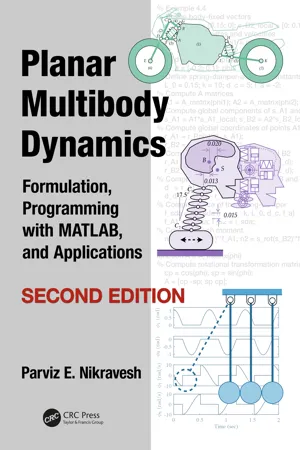Technology & Engineering
Kinematics of Particles
Kinematics of particles is the study of the motion of individual particles without considering the forces causing the motion. It involves analyzing the position, velocity, and acceleration of particles over time. By using mathematical equations and principles, kinematics helps in understanding and predicting the behavior of particles in various engineering and technological applications.
Written by Perlego with AI-assistance
Related key terms
4 Key excerpts on "Kinematics of Particles"
- eBook - ePub
- D. Gordon E. Robertson, Graham E. Caldwell, Joseph Hamill, Gary Kamen, Saunders Whittlesey(Authors)
- 2013(Publication Date)
- Human Kinetics(Publisher)
PART IKINEMATICSKinematics is the study of motion without regard to causes. Studying human motion in the past was a time-consuming, laborious, and expensive task because cinematography was employed and manual methods were needed to extract the trajectories of body parts from the film. Advances in technology have automated much of the processes of capturing motion data electronically and then extracting the two- or three-dimensional trajectories. Such technology is now commonplace in the motion picture industry, but biomechanists use additional software to obtain time derivatives of the various trajectories or combine the trajectories to reconstruct the motions of body segments and joints so that differences in motion patterns can be readily identified. Kinematics is also the first step to analyses by inverse dynamics (covered in part II ) that estimate the causes of the motion. In this part, chapter 1 outlines how to record two-dimensional kinematics electronically, photographically, and videographically and how to extract digital data from the recordings. Chapter 2 outlines the additional mathematics and processing needed for three-dimensional kinematics. Note that chapter 12 outlines data smoothing techniques that are also important to the valid processing of kinematics, particularly accelerations. Several of the appendixes also have information concerning electronics (appendix C ) and mathematical principles (appendixes D and E) that are required for data collection and analysis in kinematics. Note that text in boldface is a concept described in the glossary at the end of the book.Passage contains an image
Chapter 1Planar KinematicsD. Gordon E. Robertson and Graham E. CaldwellK inematics - eBook - ePub
General Physics
Mechanics and Molecular Physics
- L D Landau(Author)
- 2013(Publication Date)
- Pergamon(Publisher)
CHAPTER I PARTICLE MECHANICS Publisher Summary The fundamental concept of mechanics is that of motion of a body with respect to other bodies. The relativity of motion arises from the relativity of the concept of space itself. This chapter discusses the principle of the relativity of motion. It is reasonable to begin the study of the laws of motion by considering the motion of a body of small dimensions. The motion of such a body is especially simple because there is no need to take into account the rotation of the body or the relative movement of different parts of the body. A body whose size may be neglected in considering its motion is called a particle and is a fundamental object of study in mechanics. The possibility of treating the motion of a given body as that of a particle depends not only on its absolute size but also on the conditions of the physical problem concerned. The position of a particle in space is defined by specifying three coordinates, for instance, the three Cartesian coordinates x, y, z. For this reason, a particle is said to have three degrees of freedom. The motion of a particle is described by its velocity. The chapter also discusses momentum, motion under reactive forces, centre of mass, acceleration, force, dimensions of physical quantities, motion in a uniform field, work and potential energy, the law of conservation of energy, internal energy, boundaries of the motion, elastic collisions, and angular momentum. Besides energy and momentum, another vector quantity called angular momentum is conserved for any closed system. This quantity is the sum of the angular momenta of the individual particles - eBook - ePub
Planar Multibody Dynamics
Formulation, Programming with MATLAB®, and Applications, Second Edition
- Parviz Nikravesh(Author)
- 2018(Publication Date)
- CRC Press(Publisher)
3Fundamentals of Planar Kinematics
This chapter presents a summary of some fundamental concepts of planar kinematics. We first review the kinematics of a single particle, and then we consider the fundamental formulas for the kinematics of a single planar rigid body. Definitions for arrays of coordinates, constraint equations, degrees of freedom, and kinematic joints are also discussed.The kinematic definitions and fundamental formulas for Kinematics of Particles and rigid bodies that are discussed in this chapter will be used extensively throughout this textbook. Therefore, it is important to understand these simple but fundamental formulas at this point. Exercises with MATLAB® are provided to carry out most of the computations, even though most of the examples are very simple and the calculations may be performed on paper. It is our intent to use MATLAB as much as possible and be prepared to solve more complex and realistic problems whenever needed.3.1 A Particle
The simplest body arising in the study of motion is a particle , or a point mass . Analysis of the behavior of a point mass can lead to the kinematic and dynamic analysis of a body, and eventually to the analysis of a system of bodies. Therefore, it is essential to study the Kinematics of Particles first. In this textbook, we use the terms particles and points interchangeably.3.1.1 Kinematics of a Particle
The most fundamental step in planar kinematics is to describe the position of a particle or a point in a plane. A plane is described by a nonmoving Cartesian reference frame x–y . The position of a typical particle A in the plane is described by vectoras shown in Figure 3.1 . The components of the position vectorr →A, or the x–y coordinates of particle Ar →A - David V. Guerra(Author)
- 2023(Publication Date)
- CRC Press(Publisher)
7 Kinematics
DOI: 10.1201/9781003308065-77.1 Introduction
Thus far in this volume, the motion of the objects analyzed was simply at rest or in the case of the magnetic force, moving at a constant speed at one instant of time. The techniques applied to analyze a situation were centered around the analysis of vectors. A diagram was produced, vector components were found, an expression was applied, and solutions were found.At this point in the volume, the topic of kinematics, which is the terminology and the analysis employed to study the motion of objects, is introduced. The solutions to the problems in this chapter are associated with the definitions of different types of motion and not focused on the components of force vectors. Therefore, the pattern of analysis established in the previous chapters is not applied in this chapter, but it will return in the next chapter after the terminology and techniques of kinematics are studied.- Chapter question: A family makes an 800 km trip, strictly eastward, as described in Figure 7.1 . The family travels the first half of the trip distance at 80 km/h, quickly speeds up, and then maintains a speed of 100 km/h for the second half of the trip distance. For this entire trip, is the average speed 90 km/h? This question will be answered at the end of the chapter using the formal mathematical study of motion, called Kinematics, which is the topic of this chapter.
FIGURE 7.1 Family trip.
7.2 Kinematic Definitions
Kinematics, first developed by Galileo, is the formal study of the motion of objects using diagrams, graphs, and equations. In the previous chapters, the analysis employed assumed the objects were either at rest or moving at a constant speed. Situations under these conditions are known as a static, because the forces are balanced. When the forces become unbalanced, accelerated motion results. In this chapter, the terminology used to describe all types of motion is formalized in preparation for subsequent chapters in which the resulting motion of unbalanced force will be studied. This chapter will start with a definition of displacement and then explore velocity and acceleration in both graphical and analytical formats. It is important to realize that the problem-solving techniques employed in this chapter are different than those used in the previous and subsequent chapters, and this is only a brief aside to introduce the terminology and practices of kinematics.
Index pages curate the most relevant extracts from our library of academic textbooks. They’ve been created using an in-house natural language model (NLM), each adding context and meaning to key research topics.



